



CFA
Oriental Breed Profile
CFA
Oriental Breed Standard
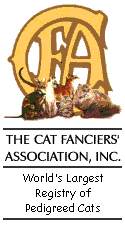
| |
The Oriental Shorthair……
on the ORIENTAL EXPRESS
By Vicky Markstein
From the 1978 Annual CFA Yearbook, pages
257-268, published with permission of CFA
|
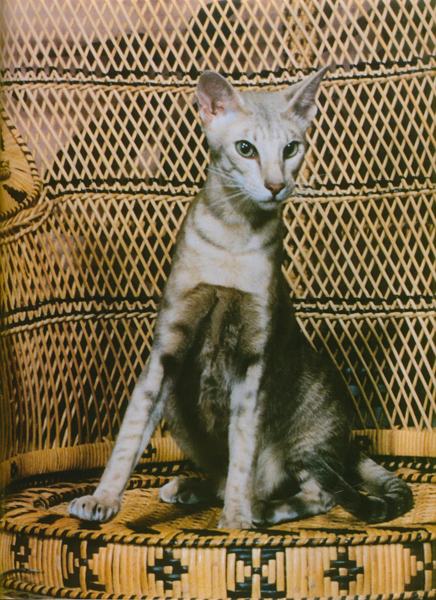
GR. CH. SAND N'SEA BIKKURI OF JEMWYCK
Photo by L. Levy
|
The
1977-78 show season was the first championship year for the Oriental
Shorthairs (OSH) and what a first year it was! Gr.Ch. Sand N’ Sea
Bikkuri of Jemwyck finished in the National Top Twenty, several Oriental
Shorthairs placed in their region’s Top Ten and seven Orientals earned
Grand Championship titles in the following colors: tortoiseshell,
spotted lavender tabby, solid lavender, solid ebony and blue cream.
Patapaw Justa Foo-lin, the tortie, was CFA’s first OSH Grand Champion.
In addition to this impressive display of grands, the show bench
statistics published by the Oriental Express showed that 40 different
Orientals won major CFA final awards. To the best of my knowledge, no
other breed has achieved these results in its first year in competition.
Certainly no one can dispute the depth of quality of the Oriental
Shorthair when so many cats have received recognition on the show bench.
The Oriental Shorthairs are well on their way to fulfilling Dr.
R
. Peltz’s prophecy “And now we have two new breeds (Oriental
Shorthairs and Exotic Shorthairs) personifying the extremes of body type
that, in 20 years, will be the truly elegant cats of the fancy.” (Cat
World Jan-Feb 1976)
The
Oriental story as it is recounted here is all about a few people who sat
around a fire and designed a hypothetical cat, the roll of a well
organized breed club, and the importance of an open minded cat registry.
The people are the pioneer Oriental breeders, the breed club is Oriental
Shorthairs International (OSI), and the cat registry is C.F.A.
In
addition, the following topics will be discussed:
Definition of the
OSH
breed.
Early
OSH
breeding programs.
Organization of the
OSH
in CFA.
Discussion
of standards and color descriptions.
|
|
DEFINITION
OF THE ORIENTAL BREED
Before
defining the Oriental Shorthair breed, let us review some commonly found
dictionary definitions of the word “breed”:
“a relatively homogeneous
group of animals within a species, developed and maintained by man.” The
Random House Dictionary of the English Language.
“a group of domestic animals
developed through the influence of man, either intentionally or
unintentionally, and requiring control by man to prevent mixtures with
other races, and consequently loss of the distinctive characteristics.
Breed, in this sense, designates a more extensive group than strain, and
does not imply directly traceable descent from a particular individual.
“a distinctive group of
domestic animals differentiated from the wild type under the influence of
man and usually incapable of maintaining its distinctive qualities in
nature.” Webster’s New International Dictionary.
Clearly
it is man who selects the individuals to perpetuate a breed and not
nature.
There
are several ways to choose the distinctive characteristics of a breed. The
oldest method is to select an unusual feature which is found in nature.
Man then prescribes the other characteristics which, based on his sense of
esthetics, compliment the hosen feature. For instance, the naturally
occurring pattern which geneticists refer to as the Himalayan factor was
expressed over several species. In particular the shorthair cat which
today is known as the Siamese carries this color pattern. However, the
conformation was prescribed by man, and realized only after many years of
selective breeding. Photographs of Siamese cats taken only 80 years ago
show a quite different conformation than today’s show Siamese.
Similarly, today’s shoe Persian is barely recognizable from those
depicted in Frances Simpson’s “Book of the Cat” (1903).
So
one way a breed can be started is to take a naturally occurring
characteristic such as a color pattern or hair length and superimpose a
rigid man-made standard for type.
Later
breeds were developed by combining two naturally occurring characteristics
onto a single cat. The Himalayan breed is an example of such a design
which combined the Siamese pattern with the Persian coat.
In
recent years, breeds have been started using man-made standards as the
basis for the cat, rather than a “naturally occurring characteristic”.
The Oriental Shorthair and the Exotic Shorthair are two breeds which were
designed by this last method.
In
particular, the Oriental Shorthair designers started with a man-made
standard for the Siamese cat without the color pattern. The philosophy of
the original designers was that conformation alone would define the
OSH
breed. The entire spectrum of colors offered by nature would be used to
enrich the breed.
In
short, the Oriental Shorthair can be defined as a highly stylized cat
having man-made Siamese type with green eyes developed in all naturally
occurring colors. The Oriental Shorthair is a hybrid breed and it is
intended to remain thus.
“Perhaps
I should digress here to say that there is no such thing as “taint” or
“stigma” from hybridism in a breed which is deliberately created by
this means and bred to a strict physical standard as stringent as any
standard used for the Natural breeds. Here hybridism is a mark of
excellence, a badge of distinction, …….., considered to produce the
highest degree of perfection, desirability, beauty or usefulness.” Jane
Martinke, Cats Magazine, Feb, 1972.
|
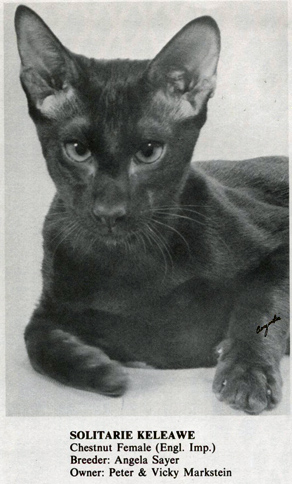
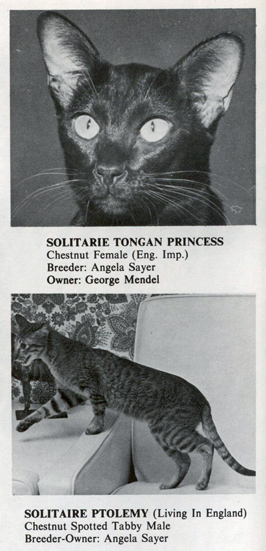
|
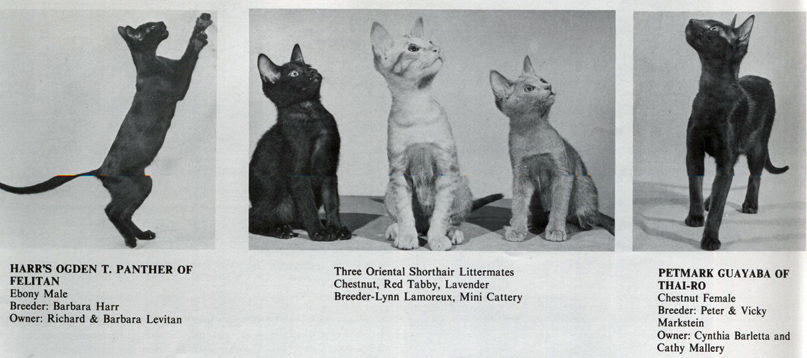
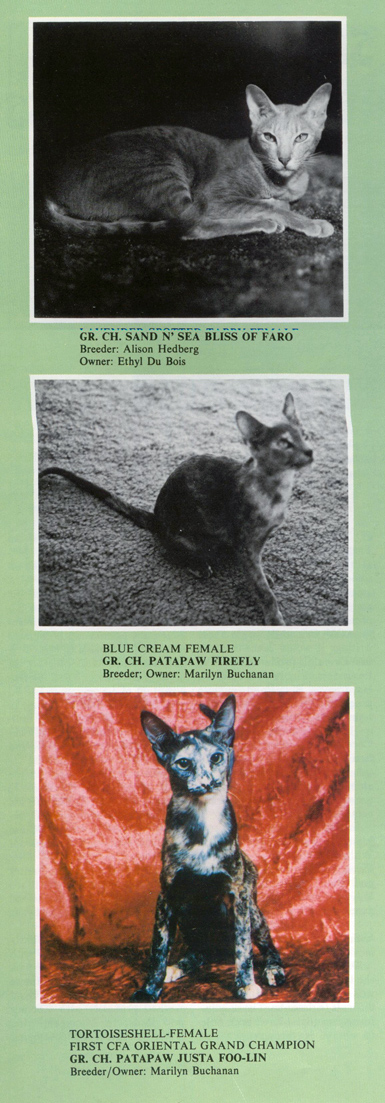
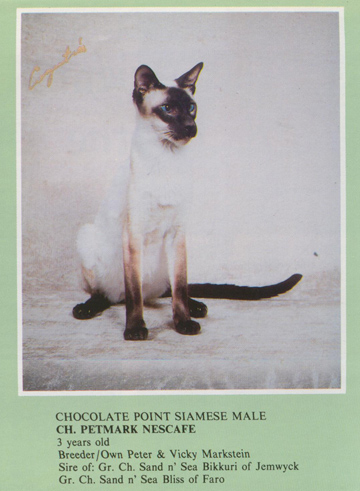
|
EARLY
OSH BREEDING PROGRAMS
ENGLAND
As far as can be determined the first
Oriental breeding programs were started in
England
about 1950. “One cold winter evening in 1950, sitting comfortably by a
roaring fire, I idly played with the idea of breeding a new variety of
cats…… My vague wish to breed something new slowly matured into an
ambition to breed a self-coloured brown cat with green eyes, shorthair and
of foreign type. “ wrote Baroness von Ullman of
Roofspriger Cattery, and mentioned her close collaboration with Mrs. A
Hargreaves of Laurentide Cattery, and with Mrs. E. Fisher. The first
published photographs of
OSH
kittens were of two Chestnuts. These appeared in “Our
Cats”, Aug, 1954. The two kittens illustrated were Craigiehilloch
Bronze Wing and Craigiehilloch Bronze Leaf bred by Mrs.
R
. Clarke of
Reading
.
Later,
a 1956 issue of “Our Cats”
carried a very informative article by Mrs. A. Hargreaves describing her
experiments in producing Blue Point and Lilac Point Siamese.
“I mated a Seal pointed queen
to a
Russian Blue male…… As expected, the first litter was all black ….
Some of these blacks were mated together, and some back-crossed to the
most suitable Siamese studs …. Having finished breeding Siamese from
Jet, the one original black cat still in my possession, I decided to make
use of her in another way. As a result she is the great-grandmother to
some Chestnuts…..”
It
is most interesting to note that the same black domestic female which was
used to produce some of Laurentide’s world famous Siamese was also used
to produce Mrs. Hargreaves’ first Chestnut Orientals. Two of these
famous Siamese studs were Laurentide Mercury and Laurentide Quicksilver
which appear on many English pedigrees such as Doneraile and Annelida.
These two studs are even as close as the fifth generation behind some of
CFA’s top winning Siamese. Of course today Mercury and Quicksilver would
not be represented as Siamese, but rather as AOV Orientals! From these
writings it would seem that the first Orientals produced where the
Lavenders, a by-product of Mrs. Hargreaves’ Blue Point Siamese program.
Mrs. Fisher exhibited a Laurentide Lavender in
England
in 1950. However, it was the Chestnuts in 1958 who were the first
Orientals to gain recognition in GCCF (English equivalent of CFA). The
Lavenders were the second color to gain acceptance in GCCF.
In
1962, three concurrent programs to produce the Oriental Whites were
started by Mrs. E. Flack, Mr. Brian Stirling-Webb and Pat Turner. The
Oriental Whites were the third color to be accepted.
U.S.A.
Oriental
Programs started in the
U.S.A.
are unfortunately not well documented and therefore difficult to describe.
The only information I have been able to obtain is through personal
contact with those breeders who had long term breeding programs and who
were working toward breed recognition. Mrs. Ann Billheimer of
Florida
, the breeder of Gr.Ch. Tawnee Ballerina started developing Lavender and
Chestnut cats of Siamese type in 1968. It was Mrs. Billheimer and Mrs.
Hackett of
New York
who initiated recognition of Lavenders in C.F.A. At the 1972 Board meeting
in
Atlanta
Georgia
, Mrs. Billheimer presented one of her beautiful Lavender males, and the
minutes of this meeting reflected great enthusiasm on the part of the
board members. In spite of the Board’s interest, the Lavenders never
advanced beyond registration status because the 100 required cats had not
been registered. In 1974 Mrs. Billheimer wrote to me, “After six years,
I would sure like to see them do more than be household pets, and I am
with you and your club all the way.”
On
the West Coast in the early 1960’s, Irene Gizzi, along with several
other breeders undertook a program to develop Siamese type cats of all
colors. Ms. Gizzi worked primarily with Ebonies and
R
eds. In
Michigan
, Mrs. Betty Purseglove was developing a white program, additionally she
worked with several other colors as well.
The
Oriental Shorthair International (OSI) records show Oriental meetings in
the early 1970’s by Judy Broadbent, Marjorie Jordan, Lynn Lamoreux, Sid
and Pauline Thompson, John Smith, and Dorothy and Donald Wilbur.
Certainly
there must have been several other
U.S.
breeders working toward the Oriental goal. I deeply regret not knowing of
their work and breeding programs and I would greatly appreciate hearing
from them so that a more complete history can be written in the future.
page
1 of 4
|
CONTINUE TO PAGE 2 |




